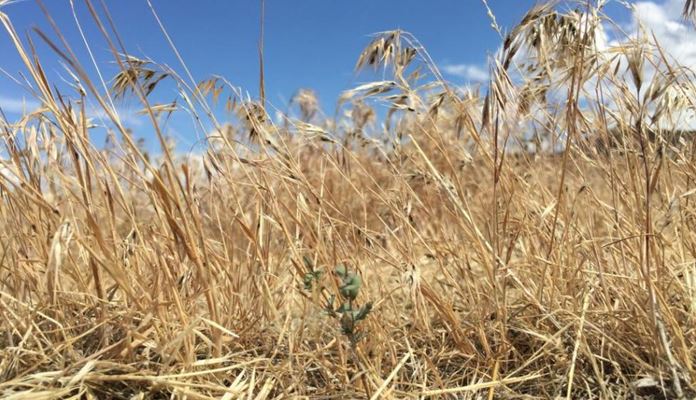
Feb. 11 (UPI) — After an uptick in massive wildfires and the loss of thousands of acres of sagebrush wildlife habitats, Western states are creating a regional battle plan to attack invasive annual grasses.
Quick-growing cheatgrass has galloped across the Great Basin states, crowding out native plants and providing a dry, fine fuel source that doubles the risk of wildfire on the rangeland, scientists say.
Cheatgrass crowds out the native bunch grasses, and when it burns, it knocks out sagebrush steppe habitat, home to the embattled sage grouse and 350 other animals. Its abundant sharp-spiked seeds irritate the eyes, nostrils and mouths of livestock and wildlife.
The Western Governor’s Association’s Invasive Species Initiative has announced a special working group to fight cheatgrass and protect areas in the West where it hasn’t taken over.
The states have a lot of work to do. Some 50 million acres are infested with cheatgrass in the United States.
Cheatgrass, also called broncograss, marching grass and Mormon wheat, was introduced from Asia 100 years ago in shipping containers. The grass has marched relentlessly across the country, invading the fragile ecosystems in Nevada, Arizona, Idaho, Wyoming, Colorado, California, Oregon and Utah.
In winter, while perennial native grasses lie dormant, cheatgrass gets an early start, soaking up water and broadcasting its seeds. By summer, it dies, leaving dry, dead grass across the landscape.
“You find these spiky seeds in your socks when you walk through the farm. First you see a little bit, and the next year, you see more. Suddenly you have it — cheatgrass Chernobyl,” said hay farm operator Rose Brinks, 84, of LaPorte, Colo.
But the real threat of invasive grasses is wildfire.
In July, 2018, the Martin fire burned a stretch of Nevada’s Owyhee Desert, scorching 430,000 acres of sagebrush steppe habitat. The burn scar was visible from space.
The dried grass acts like kindling in a campfire, changing the fuel structure of the ecosystem, said Emily Fusco, a post-doctoral biology researcher at the University of Massachusetts, who studies wildfires and invasive grass.
“A new grass moves into the system that provides a new type of fuel and is easily combusted,” Fusco said in an interview.
The Martin fire was the largest in Nevada history, said Matthew Glenn, habitat restoration biologist with the Nevada Department of Wildlife. It was followed by the South Sugarloaf fire in August, 2018, which claimed almost 300,000 acres.
“Cheatgrass lends itself to these megafires,” Glenn said. While sagebrush is damaged and weakened, cheatgrass quickly recovers after a fire. The cheatgrass burns again a few years later in a “feedback loop,” which eventually kills off sagebrush, he said.
In some areas of the West, cheatgrass has won the battle.
The Snake River Plain in Idaho, for example, has become essentially grassland now, said Portland, Ore.-based Jeremy Maestas, sage ecosystems specialist with the U.S. Department of Agriculture’s Natural Resources Conservation Service.
“More weeds leads to more fire, leads to more weeds. There’s a big fire every three to five years instead of every 50 to 100 years.”
In December, the U.S. Department of Agriculture, U.S. Fish and Wildlife Service and various state agencies rolled out the “Idaho Cheatgrass Challenge” to proactively remove cheatgrass from sagebrush areas that are still intact to try to protect and expand the core sagebrush regions.
“It’s essentially a battle plan,” Maestas said. Other states working with the governor’s association are creating similar plans.
And if cheatgrass is bad, other invasive grasses that follow are even worse, said Ann Kennedy, a Pullman, Wash.-based retired soil scientist for the USDA’s Agricultural Research Service.
Medusahead and ventenata grass from Russia often take over after cheatgrass has invaded a habitat.
“Cattle can graze on cheatgrass when it’s still green, but these other grasses are so full of silica, they have little nutritional value and give animals problems with their teeth,” Kennedy said.
Kennedy is an expert in the battle of invasive grasses. With researchers at Washington State University, she developed a microbial weapon that soon might be available to farmers.
Specially grown bacteria attack invasive grass roots over the winter and inhibit the plants’ growth. The bio-herbicide developed by Boise-based Biowest is awaiting EPA approval, said Kennedy, who now works as a plant consultant.
The USDA’s Maestas said state and federal agencies finally are working together this year to face the challenge of invasive grass and try to stop it before it takes over.
“The problem [with invasive grasses] has been building up for 100-plus years and has only gotten worse. You have to have respect for plants that are as adaptable as cheatgrass, that have moved to another continent and thrived.
“But our native ecosystems are extremely resilient, and can beat cheatgrass. If we help them, they have a chance.”






